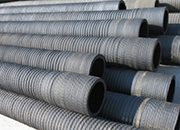Choosing the Right Oil Hose For Your Needs
2022-10-10 14:36:26
Due to increased demand for petroleum, the oil hose market will continue to grow. Oil hoses are made from different materials, making them very convenient for different types of applications. Technological advancements in the oil industry will also help in making transportation easier and cheaper. These hoses are also resistant to a variety contaminants.
1.5 inch suction and discharge rubber hose
You should consider your needs and the type of application that you are using the hose for when choosing the right suction/discharge rubber hose. A large hose is required if you are going to transport a large amount of material. In addition, wide hoses will allow for a wider flow of material. By understanding these basic requirements, you will be able to purchase the right suction and discharge rubber hose and fittings.
Suction & discharge hoses are flexible and semi-rigid hoses made of PVC or rubber compounds with spiral reinforcement to prevent the hose from collapsing. These hoses are used to discharge liquids and other media from non-pressurized sources. These hoses are also known as "hard suction" and come in a variety of sizes and styles with different couplings.
rubbe oil suction hose
Rubbe oil suction hose is a great tool for the automotive industry, and is used to convey fluids in and out of vehicle fuel tanks. This type of hose is available in different sizes, colors, and materials. It can be purchased from a variety of manufacturers, including Excel Flex, Sandhyaflex, and Flexima Premium.
A Rubbe oil suction hose is made of a durable black NBR rubber that is designed to withstand petroleum products. It can be used for diesel, gasoline, or industrial oils. It can withstand the harshest conditions without breaking down. This hose is made from copper wire and synthetic compounds. It has an oil-resistant, rust-resistant lining.
Oil suction hoses are made to handle petroleum products, including crude oil and drilling mud. They are also suitable for cleaning oily waste and other oily substances. These hoses can be used in both high-pressure and low-pressure environments.
fiber braided oil hose
These oil hoses can be braided fiber to suit many applications. They have a reinforced nylon outer shell and a stainless-steel core. They can withstand temperatures ranging from -40 to 150 degrees Fahrenheit. They are also lightweight and flexible. They can be used with many fluids, depending on the application.